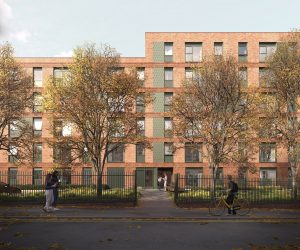A Passion for Passivhaus

Buttress’ Alison Haigh is a Passivhaus certified consultant and James Lewis is Buttress’ Leeds studio head.
If we stopped you in street and asked you what Passivhaus meant – would you know what we were talking about? Probably not and it’s not surprising. There are a lot of new terms in the built environment vocabulary and Passivhaus is one of them: and one that will likely stay in our vernacular.
Passivhaus is a building standard and an important one. In 2019, the World Green Building Council found that buildings are responsible for 39% of global energy-related carbon emissions: 28% from operational emissions, from the energy needed to heat, cool and power them, and the remaining 11% from materials and construction.

Alison Haigh
Passivhaus is a tried and tested solution for reducing operational energy, backed by over 30 years of international evidence. It gives a range of proven approaches to delivering net-zero-ready new and existing buildings, optimised for occupier health and wellbeing and a decarbonised grid. Passivhaus buildings provide a high level of occupier comfort using very little energy for heating and cooling.
The first Passivhaus prototype was built in Germany in 1992 and is still performing today. Although it is predominantly associated with housing, Passivhaus has been applied to several building types. In the UK, Passivhaus design can be found in schools, offices, archives and a leisure centre.
Passivhaus buildings can offer several long-term advantages to the occupier:
Affordability
Passivhaus, by its very design requires less energy to heat the home which is one factor that could address fuel poverty. It’s not just more affordable to operate, it can also offer lower maintenance costs, which has proven to be a good way for social housing providers to guarantee affordable homes.
Reduced Rent Arrears
By incurring drastically reduced energy bills, residents can afford to live comfortably, leading to an improved customer experience, which has been found to reduce rent arrears.
Increased wellness and healthy homes
Passivhaus-designed homes have a lack of draughts, cold spots, mould and condensation and create comfortable temperatures and clean internal environments throughout the seasons. The continuous fresh clean air provided by the ventilation system, known as Mechanical Ventilation and Heat Recovery or MVHR provides excellent indoor air quality.

James Lewis
What are the challenges to Passivhaus?
Passivhaus concepts are relatively new, and as such it can be difficult to get an experienced contractor and design team on board. Both need to thoroughly understand the Passivhaus concepts.
Understandably, costs can be a concern, largely an uplift in capital expenditure. However, experience has shown that the increase in costs associated with applying the standard can be mitigated as long as the principles drive the design from the very start.
To achieve Passivhaus standards within a budget, it is reasonable to expect cost savings must be sought from elsewhere. An experienced team will create a compact build form and simplify the architectural detailing, thermal and airtightness. This means that it will be easier to meet the stringent airtightness requirements and that most of the heat demand is met by internal heat gains from people and equipment. As a result, the heating plant is far smaller, and the cost savings can be spent on triple glazing, openable windows and highly efficient ventilation systems.
There are additional costs due to the associated certification and quality assurance process. However, this has its benefits to the occupier as this ensures that the project is built as designed with little or no gap in performance.
Buttress’ Passivhaus Experience
Working for client, the English Cities Fund, Buttress has been developing one of the UK’s largest residential Passivhaus schemes in Salford, Greater Manchester.
Greenhaus consists of two blocks; six and eight stories high, which form an L-shape that contains a public square. Overall, the scheme provides 96 units for affordable rent, with a mix of one and two-bed dwellings and four wheelchair-adaptable apartments on the ground Floor. Salford housing provider Salix Homes will manage the scheme.

Peru Street
Following on from the success and experience of Greenhaus, plans were submitted for a nearby development to Greenhaus called Peru Street for the same client. It consists of 100 high-quality, affordable, sustainable, one and two-bedroomed Passivhaus apartments within a part five and part six-story building.
Buttress has produced a guide to starting to think about putting Passivhaus into Practice with eight starter points which can be read here.
Whilst there are many sustainable accreditations in the built environment sector, Passivhaus is the gold standard and its adoption will bring about a host of benefits for the occupier. There may be challenges to introducing this approach, but the benefits will outweigh the difficulties in bringing real long-term solutions to reaching net zero and housing affordability. It’s a win/win.
Buttress looks forward to continuing its work in the Passivhaus arena and welcomes readers’ comments and questions on the certification. We’d like to encourage others to design and deliver to the Passivhaus standard to help achieve net zero carbon by 2030








